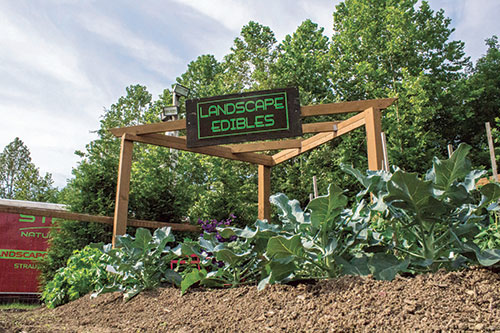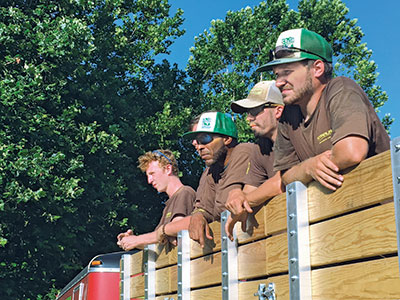
About four years ago, Zech Strauser suggested that one of his commercial resort clients do something a little different with a large, unused green space next to its basketball courts. The project, completed by Strauser for free, turned 8,000 square feet within a 2-acre space into a sustainable plant paradise. It includes native grasses and wildflowers that attract butterflies and hummingbirds, and it provides attractive displays of color from spring to fall.
“It’s absolutely beautiful,” says Strauser, president and CEO of Strauser Nature’s Helpers in East Stroudsburg, Pa. “In the first year or two, you get a lot of perennials, but as time goes on, the grass species start to take hold and they are the winning factor in the long run. The client loves it and we have since introduced more areas like this around the property.”
That project was a turning point in Strauser’s career and helped reignite his passion for the green industry, which he entered 20 years ago when he started mowing overgrown foreclosed properties with a borrowed push mower. Strauser Nature’s Helpers has since become a $3 million to $4 million company that provides 75 percent maintenance and 25 percent design/build services to a 20 percent residential, 80 percent commercial clientele. The company employs 15 to 20 year-round team members and another 20 to 30 seasonal and part-time employees, depending on the severity of the snow season.
Passion reignited
After about 15 years of steady growth, Strauser began to feel as though he’d lost his way. He says he believed there must be more to the landscape than green grass and mulched beds.
“As my company grew, I fell into a trap of following the status quo and the traditional idea of what our industry is,” Strauser says. “I asked myself, ‘Why am I inspired to be in this industry?’ and I couldn’t find any reasons. I’d started to lose the passion behind it, and we were just driving to make another sale.”
Strauser reflected on the reasons he entered the landscape industry initially, such as his love of the outdoors and being able to get some dirt on his hands. He recalled his nontraditional upbringing as a home-schooled student and the way his family “lived off the land,” spending countless hours working in their large gardens. Those experiences prompted him to reevaluate the direction his company was moving in and think of how he could do things differently to better align with his core values.
Some companies in the industry are actually “ungreen,” Strauser says, pointing to chemicals, emissions and other outputs that can be harmful if handled improperly or left unchecked.
“At the end of the day, are we creating inviting, environmentally friendly landscapes to be in?” he asks. “Not really.”
So Strauser implemented a four-part approach he calls “A Better Way,” which breaks down the components of a landscape project. He looks at each project’s environmental rewards, financial and aesthetic benefits, and how people can have more interaction with the landscape. His goals include decreasing lawns by 30 percent and replacing them with organic, native plant mixtures and reducing mulched areas by 60 to 80 percent by filling beds with plants. Strauser says a tremendous amount of resources goes into creating and maintaining large green spaces that he sees going unused. Landscapes that incorporate native plantings can be low impact and require less mowing and fewer chemicals to maintain, while creating wildlife habitats, he adds.

“Most properties have vast lawn areas that, by thinking differently, can be transformed into areas that can benefit the environment and the wildlife at the same or lower costs,” Strauser says. “These practices aren’t new—they are basically going back to what good gardening is. We are trying to introduce these ideas to clients who are used to that clean, neat appearance.”
Strauser spreads his message through his involvement with organizations such as Come Alive Outside, a nonprofit that works with landscape professionals and other groups to inspire communities to enjoy outdoor spaces, and the Chesapeake Bay Landscaping Council, which recently introduced the Chesapeake Bay Landscape Professional Certification, a formalized set of sustainable landscaping standards for the region’s landscapers. Strauser says 180 contractors—himself included—will receive the certification by the end of this year.
“It’s really exciting that there is a certification for the direction we are going,” he says. “It’s nice to see Pennsylvania get on the bandwagon.”
Strauser says getting more people on this bandwagon is one of the biggest challenges to changing the public’s perceptions of outdoor landscapes. Education will play a huge role in getting contractors and clients alike to understand and become receptive to the idea of converting unused green spaces to prairies and meadows. Since landscapes are largely driven by building developers, Strauser says they, too, need to be educated about the ins and outs of natural landscapes to ensure they are being implemented correctly from the start.
“The average landscaper is not trained in what we are talking about, so how can they sell it?” Strauser asks. “Even if the contractor is trained on speaking about native plants and their lesser impacts, the client likely has never heard of it and won’t want to turn (his) property into a nature sanctuary. How do we narrow down this broad world into actionable goals? I believe these challenges are changeable and we can influence both sides. But it’s going to take time.”
In light of all his efforts, Strauser wants to make one thing clear: “By no means are we this 100 percent green company that is only doing really exciting things. We still have accounts and take care of many sites that don’t have anything to do with what we are talking about,” he says. “But at the same time, that work helps support and fuel our true initiative, and hopefully we can inspire others to go in this direction too.”
Photos: Strauser Nature’s Helpers


